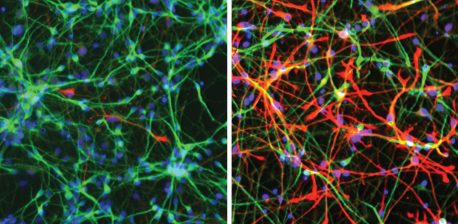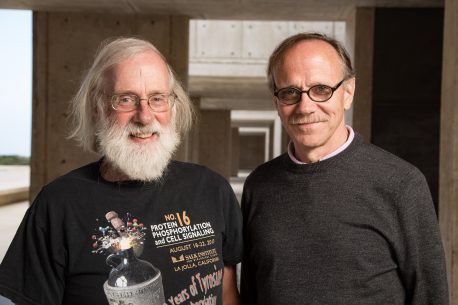
July 12, 2016
A new understanding of how developing brain cells come to rely on oxygen may inform the treatment of brain diseases
A new understanding of how developing brain cells come to rely on oxygen may inform the treatment of brain diseases
LA JOLLA—Our brains can survive only for a few minutes without oxygen. Salk Institute researchers have now identified the timing of a dramatic metabolic shift in developing neurons, which makes them become dependent on oxygen as a source of energy.
The findings, published July 12 in the journal eLife, reveal a metabolic route thought to go awry in cancer and neurodegenerative diseases, such as Alzheimer’s and Parkinson’s disease.
“There is relatively little understanding about how neuron metabolism is first established,” says co-senior author Tony Hunter, holder of the Renato Dulbecco Chair and American Cancer Society Professor in Salk’s Molecular and Cell Biology Laboratory. “Aside from enabling us to understand this process during neuronal development, the work also allows us to better understand neurodegenerative disease.”

Click here for a high-resolution image
Credit: Salk Institute
To send messages along neurons is energetically demanding, and the brain uses both oxygen and glucose intensely. The brain, for example, uses 20 percent of the body’s glucose supply. The cell’s energy-producing factories, called mitochondria, are scattered throughout the long, slender axons of neurons in order to provide all parts of the cell with a constant supply of energy. As the neurons get bigger, so do the number of mitochondria, according to the new study.
We make new neurons in the womb, and this process continues after birth. Even a few areas in the adult brain continue to make new neurons throughout life. “We assume that the metabolic shift we describe in this new study happens every time a progenitor cell turns into a neuron,” says the study’s first author Xinde Zheng, a Salk research associate.
The cells that eventually become neurons initially use a pathway called glycolysis, which is a major energy-producing process that takes place in the cytoplasm of the cell and turns glucose into energy in the form of adenosine triphosphate (ATP). At some point, however, the cells switch to a more efficient pathway called oxidative phosphorylation, a process that uses oxygen to produce ATP and occurs inside the mitochondria.
Hunter, Zheng, Salk’s Leah Boyer and colleagues previously studied a rare metabolic disease called Leigh syndrome and recently published work showing that less ATP is produced in afflicted neurons. In the process of understanding that disease, they needed to recreate it in a dish, using cells with mutations in the DNA contained within mitochondria. But the team realized that it was not well understood how normally dividing cells generate energy while they divide and differentiate into new cell types.
In the new study, Hunter’s team found that as a neuron precursor cell becomes a neuron, genes coding for key metabolic enzymes used in glycolysis switch off their expression,. Those changes work hand in hand to shut down glycolysis. All the while, key regulators of oxidative phosphorylation are ramping up.
Most surprising is that developing neurons must completely shut down glycolysis, says Hunter. When the researchers prevented that from happening, the neurons quickly died.

Click here for a high-resolution image
Credit: Salk Institute
“This is the first comprehensive analysis of metabolic changes during neuronal differentiation, and the surprising reliance of neurons on oxidative phosphorylation for their sole energy source has clear implications for neuronal vulnerability with age,” says co-senior investigator Rusty Gage, a professor in Salk’s Laboratory of Genetics and holder of the Vi and John Adler Chair for Research on Age-Related Neurodegenerative Diseases.
The group plans to look more closely at how the metabolic genes are controlled in developing cells. They also plan to study neurons harboring energy defects associated with disease, such as Parkinson’s disease, and different types of neurons to compare any finer differences in metabolism.
Other authors on the study are Mingji Jin, Jerome Mertens, Yongsung Kim, Li Ma, Li Ma, and Michael Hamm, all of the Salk Institute.
The research was supported by the National Institutes of Health, the G. Harold and Leila Y. Mathers Charitable Foundation, the JPB Foundation, the Leona M. and Harry B. Helmsley Charitable Trust, Annette Merle-Smith, the California Institute for Regenerative Medicine, and the Helmsley Center for Genomic Medicine.
JOURNAL
eLife
AUTHORS
Xinde Zheng, Leah Boyer, Mingji Jin, Jerome Mertens, Yongsung Kim, Li Ma, Li Ma, Michael Hamm, Fred Gage, Tony Hunter
Office of Communications
Tel: (858) 453-4100
press@salk.edu
Unlocking the secrets of life itself is the driving force behind the Salk Institute. Our team of world-class, award-winning scientists pushes the boundaries of knowledge in areas such as neuroscience, cancer research, aging, immunobiology, plant biology, computational biology and more. Founded by Jonas Salk, developer of the first safe and effective polio vaccine, the Institute is an independent, nonprofit research organization and architectural landmark: small by choice, intimate by nature, and fearless in the face of any challenge.